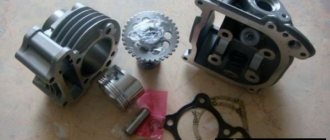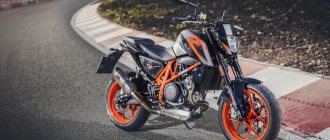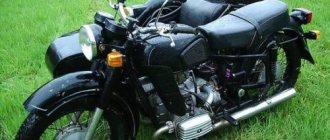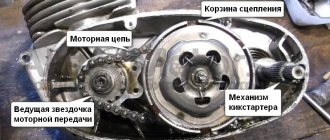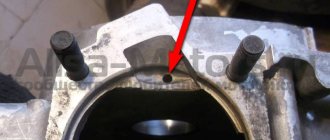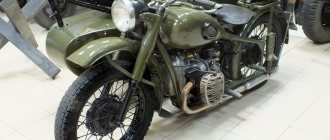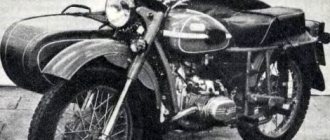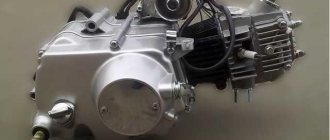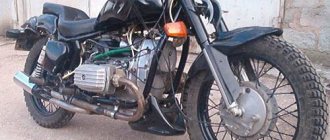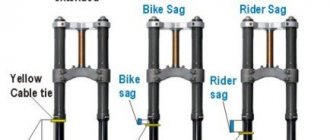How to tune a Dnepr motorcycle with your own hands
We improve engine performance, replace carburetors and ignition systems with more advanced ones.
We change the appearance to sport or chopper. The Dnepr MT 11 motorcycle comes from the Soviet Union, which was produced at the Kiev Motorcycle Plant. This heavy equipment was created to overcome difficult rural roads, transport goods to hard-to-reach settlements and tow small trailers. Thanks to the sidecar drive and reverse gear, the Dnepr motorcycle had high maneuverability, maneuverability and was an indispensable assistant in the household. Nowadays, tuning the Dnepr motorcycle does not lose popularity due to its ease of repair, the availability of accessible spare parts, and also falls under the “Retro” category, which is becoming more and more popular every year.
In this article we will tell you why Dnepr tuning is so interesting to this day. We will also talk about tuning the Dnepr engine, increasing power, maximum speed, and improving appearance.
Mini-tractor with an engine from a Ural motorcycle | Step-by-step assembly photos
Dear visitors to the “ Samodelkin Friend ” website, today we will look at detailed instructions on how to make a mini-tractor with an engine from a Ural motorcycle with your own hands. This tractor is created on the basis of a breakable frame welded from professional pipe with a cross-section of 100x40 mm. The engine is installed from a Soviet heavy motorcycle "Ural" purchased from a nearby scrap metal collection point. The tractor has 2 boxes, one is a “original” motorcycle box, and the second is from a Moskvich-412 car. The tractor has all-wheel drive on all 4 4x4 wheels. The engine cylinders are equipped with additional air cooling, carried out from adapted VAZ stove motors, namely fans in a tin casing. Steering, traction "Moskvich" The mini-tractor aggregates a plow, a car trailer, a blade and other useful attachments. The ignition on the tractor is electronic.
Living in rural areas, such an assistant as a home-made tractor is simply irreplaceable; with its help you can plow and cultivate a vegetable garden, transport various loads on a trailer (firewood, manure for the garden, hay, crops collected from the plot). In general, the equipment is very useful.
Let's look at step-by-step photos of assembling a mini-tractor.
Materials
Tools
Step-by-step instructions for creating a mini-tractor with an engine from a Ural motorcycle with your own hands.
The first step was to weld the frame; it will consist of two parts and is connected to each other by a breaking point. The material used was a 100x40 mm pipe, 2000 mm long and 950 mm wide.
The tractor transmission, shortened rear axle stockings are from a VAZ 2103, torque from the gearbox is transmitted through a chain drive to the sprocket, and from it through shortened cardan shafts to the front and rear axles.
Frame swivel unit.
The frame is assembled and the wheels are installed.
Installation of a gearbox from a Moskvich-412 car
The engine from the Soviet heavy motorcycle "Ural" was purchased from a metal collection point and restored.
Interface of internal combustion engine and gearbox.
Electronic ignition from a VAZ 2108 car.
Installation of electrical equipment, as well as additional forced cooling for engine cylinders.
Turn signals and brake lights.
This is such a wonderful mini-tractor.
This tractor has good characteristics and optimal specific power, which allows it to plow the ground with a plow with two moldboards and haul a car trailer with a load of more than 500 kg.
The tractor also has a blade for clearing snow in winter. You can watch the video and see for yourself. Enjoy watching. We hope you liked the material. Thank you for your attention!
Source
Engine tuning Dnepr
The main feature of any Dnepr MT model is the engine lubrication system. It should be improved first of all, since this is a disease of all Dnepr motorcycles. The problem is that the oil is poorly cleaned at low engine speeds (up to 3000 rpm). There is no oil filter in the engine. Its role is played by a “centrifuge”, which should be replaced with a “cap-plug” and an external automobile oil filter should be installed. And in the “guitar” of the engine, make grooves for the sealing rings for stable oil pressure.
This procedure will allow:
- increase the oil pressure in the system
- improve the quality of lubrication of the crankshaft and other rubbing parts
- increase oil change intervals
- double the service life of the Dnepr motorcycle engine
Now you don’t need to remove and disassemble the engine every 10,000 km to clean the centrifuge; you just need to replace the external oil filter with a new one.
When the oil supply system is back to normal, it's time to think about increasing power. Standard crankshaft bearings, connecting rods, as well as the crankshaft itself have a huge margin of safety! But the rings and pistons leave much to be desired. The ancient design of standard piston rings does not allow achieving high compression in the cylinders. To install VAZ car rings, you need to bore the motorcycle cylinders to the third repair size of 79mm and tuning the pistons.
Thanks to such rings and new pistons, you will not only get an increase in power from increased compression, but also get rid of oil wastage, excess carbon deposits in the cylinder heads and a clean exhaust. The starting of the motorcycle will be greatly improved. In addition to this, cut off 2mm of metal from the upper steps of the cylinders to increase the compression ratio and switch to 92-95 gasoline.
Let's move on to tuning the timing system - gas distribution mechanism. The main role of this process is played by the camshaft. The camshaft cam profile determines the torque range and the peak of maximum power. If you want to achieve maximum power, you need a camshaft from the MT 10-36 .
Of course, a good way to increase power is tuned carburetors. As a rule, they can be found at Japanese motorcycle dismantling sites. An excellent option would be carburetors such as Keihin CVK32 and the like. Many carburetors are suitable for different ATVs and other equipment with a similar engine size.
It will be necessary to replace the old contact ignition system with a new microprocessor one. This could be either Sovek or Saruman which is more perfect. Well, to realize such power on the highway, the 8th pair of gears in the gearbox must be replaced with a 9 or 10 pair.
Chip tuning in Tula
Recently, more and more people are trying to modernize old Soviet technology. So I got such a project, with the installation of a modern power supply and ignition system on a Dnepr motorcycle. We decided to install an Abit injection system on this motorcycle. What we got is described below. We will look at the features of installing an injector on a Dnepr or Ural motorcycle in a separate article, but in this description there is a detailed description of the project and the features of modernization and tuning of these motorcycles.
This story began when an acquaintance told me that someone had thrown away a Ural and simply needed to pick it up. A couple of days later we got ready and came to inspect the find; in fact, the Ural turned out to be the Dnieper, or rather an engine from the Dnieper, mounted on a rusty Ural frame. Somehow we dragged this miracle home on a rope. Naturally, the condition was so-so, not a trace remained of the wiring, the cables were torn, there was rust all over, the valve covers were broken. In general, a standard situation. Well, having caught my breath, I got to work. We bought all the necessary and unnecessary missing parts, a book on operation and repair, and read all the Internet resources on boxers. Whether long or short, but after three days it came to life. First trip, success. Meanwhile, it was August. After driving around a bit, having suffered with K-68 carburetors with contact ignition, experiments began with installing the BSZ. I must admit, not a single WOOFER circuit I soldered worked. It started to get colder, and somehow the work stopped by itself. But the presence of this device in my garage haunted me. After rummaging around a bit on oppozit.ru, I wanted to do something similar by spring. Well, what else can you make from boxer material if not a chopper? But making the Great Wide Wheel (GWW), another frame and all the attributes of a chopper was daunting. I found myself a new passion - bobbers.
Just in time, an advertisement for the sale of a frame from the Dnieper with documents came in handy... The next day, the frame was already lying on the roof of my car and was driving towards the dacha - the place of all the work described below. For a long time I wondered how I could make something beautiful without changing the frame. In general, the eyes were afraid, but the hands did. In agony and broken fingers, what I now call the Dnieper was born. The engine was the first to go under the knife: after disassembling it turned out that some bad person forgot to put a pressure-retaining ball in the pressure-reducing valve, i.e. the valve was constantly releasing oil pressure. Unfortunately, this was not the first surprise. All the screws that were in the motor were carefully tightened with a chisel with a blow, i.e. there were no slots anywhere. Threads were missing in half of the holes. The play in the piston was such that a screwdriver could go through; oddly enough, the liners were not worn out much, but, nevertheless, there was play. All mating surfaces (such as the plane of the front cover and the crankcase) were separated before me with a screwdriver and a hammer, i.e. were disfigured by deep cavities and risks through which oil flowed. The valves were not only not ground in; a gap of about half a millimeter between the seat and the valve was visible in the light. In general, we could go on and on about the handiness of the previous owners, but that’s not what we’re talking about now. Having removed the piston, I went to the borer, who measured everything with a bore gauge and said: “does it work?” The top of the cylinder was within par, and the bottom too, but the middle was so worn out that we couldn’t find repair pistons for boring. I had to fork out money and buy a new piston. It was decided to immediately treat the pistons with MS - 2000, so to speak, as an experiment. I didn’t replace the crankshaft with a new one (and, unfortunately, I couldn’t find the original in Tula), I just decided to grind the journals for repair. By the way, not every contra wanted to work with him. The heads were beyond the point of destruction, the original bronze guides were worn out by the “egg”, new guides from the VAZ 2108 were bought to replace them, they fit there without modifications, just like the original ones.
I did not put on the valve stem seals. The valves were purchased new and the seats were cut to fit them. After cutting everything fit perfectly. The experiments with valve springs took a long time, at first I installed springs from a VAZ 2112, but as it turned out in vain, after assembling the motor the spring compressed and closed, causing the rod to bend.
They were replaced by springs from a VAZ 2108; the original Dnieper plates had to be sharpened for them. Next came tuning! First of all, I increased the compression ratio, calculating that at E = 11 it was necessary to cut off 3.5 mm from the cylinder liner in the area where the head fits. After the preliminary assembly, I was already glad that nothing stuck anywhere, everything was spinning as it should. Flushing the combustion chambers showed that the actual compression ratio was 10.8, so be it.
Then the flywheel was subjected to torment, a good part of the meat was removed from it, after modifications its weight was 2.5 kg.
Then the heads were used, the inlet channels were bored to ~38mm, the boss under the guide was partially removed, and bored with a drill with a milling attachment.
Here, at an opportune time, a camshaft from an MT10-36 turned up for me (I had an MT 10-32), having measured its phases (240 to 240), I came to the conclusion that more anger was needed. After talking with friends at the plant, one engineer and I drew a template for a new cam profile, discussed the welding procedure with the technologist (for which I heard a lot of Russian obscenities) and finally boiled it down. The procedure, I must say, is not simple, if in short, then first the top hardened layer is ground off, then the shaft is released from the general hardening and steel is welded onto the cams (I honestly don’t remember the brand), then the desired profile is produced on a grinding machine and hardened, and then local hardening is carried out . The company does not deal with this kind of product, so it was just an experiment; time will tell whether such a design will work. The output turned out to be phases of 275 degrees (the data may not be accurate, since I am writing everything from memory, but it happened a year ago).
Well, for such a shaft, the pushers should not be simple, especially since I didn’t like my relatives for two reasons: 1) they work directly on the crankcase 2) they weigh as much as 100 grams. I made the pushers from Ural ones, machined the aluminum housings for tension into the 0.05 bottom crankcase and milled a groove for lubricating the heads.
Afterwards we got to the lubrication system: rubber rings were installed to seal the guitar-crankshaft connection, and an oil filter from Deu-Matiz was embedded into the system (by the way, it fits perfectly with the filter adapter from the Muscovite). The meaning is this: we plug the original channel from the oil pump (for example, we screwed a screw into it perpendicular to the channel), and by screwing in the tube from the gazelle clutch instead of the original technological plug, we divert the oil to the filter, after which, already filtered, we return it to the system through the pressure sensor hole , the channel to which is drilled to 6mm. At the same time, we turn off the centrifuge with a homemade “saucepan”.
Well, that seems to be it, can we collect it? They collected it and I was happy for three weeks. But then I accidentally saw an advertisement for the sale of ECU January 4.1, then I still did not understand what I was getting into and there was no one to stop me. Ebu came to me from Kirov in 2 weeks. Then work began on the injector: the first question was how to make a synchro disk? After looking at all the parts of the motor, I found the simplest option to make windows in the flywheel, and after 2 days it was born just with the help of a file and a drill. DPKV installed from VAZ.
Phase sensor too. In general, then all the sensors were VAZ ones. The next stage was the intake: it was welded from stainless steel pipes with a diameter of 38 and 51 mm.
Then I decided to install the starter. I drew a drawing, and soon they made a ring gear out of 45 steel with a hardened tooth. But horror of horrors, after trying on the starter the intake did not rise... I had to redo it. After the rework, everything began to slowly come together. I also made a tee with an RTD, replacing the fuel rail.
Actually, I’ll stop with those parts for now and switch to appearance. The appearance was also born in suffering, at first it turned out the way it turned out, then the wing was shortened, the shock absorber mounts were overcooked, etc.
I puttyed it for a long time, removed it, welded the fuel pump into the tank, and so on. In general, I’ll post photos of how and what happened. I painted it myself, using Sikkens paint, and picked up a spray gun for the first time. It didn't seem to turn out bad.
Here we go? And so, the first start, everything is connected, we turn on the power, turn on the ignition... and bummer, the fuel pump pumps without stopping, there is no spark, the injectors don’t click either. To say that I’m upset is to say nothing... Well, I have to live somehow, in the box there was a mono-injection from the Niva, prepared for my Volkswagen, well, I decided to try it with it. I assembled everything, after turning on the power, the fuel pump turned off as expected after 3 seconds, the injectors responded to cranking, there was also a spark, but the engine did not start. No matter what I did, no matter how hard I turned it, there were distinct flashes, the engine started, but did not start. I suffered and suffered, but I never started. In general, there was already an idea to switch to carbs, but the Russians don’t give up! Wandering around the Internet, I came across this site, after which, after discussing all the nuances with Sergei, it was decided to continue construction on the Corvette control unit from ABIT. This is what we have today. The receiver is made from a piece of aluminum profile, the throttle is VAZ 2112. Soon the assembly will be completed and the firmware rollback will begin.
Video:
Tuning a Dnepr motorcycle for sports
Tuning a Dnepr motorcycle with your own hands is not an easy process, but if you try, you will achieve impressive results. Before you start tuning the MT Dnepr, decide on the classification of the motorcycle. Here is a striking example of Dnepr sport tuning:
To tune the Dnepr Sport motorcycle, you will need to replace the gas tank with a more streamlined shape, install a large fairing, which you can either make yourself from fiberglass and epoxy glue, or buy a ready-made one from another motorcycle. The rear part of the frame will have to be welded to install a new seat and tail section. Of course, you can’t do without installing a fashionable brake light at the rear of the motorcycle. And the standard wide steering wheel is replaced with narrow “clip-ons”.
If the sharp shapes of the fairings and the forward-sloping landing are not to your taste, then you will undoubtedly be interested in tuning the Dnepr in the chopper . Here, you will have to scatter the entire motorcycle into parts, leaving only the engine. Use an old frame to change its geometry as much as your imagination allows. Photo tuning MT Dnepr is presented below:
The main features of the cool Dnepr motorcycle tuning are a low seating position, a large teardrop-shaped gas tank, a changed fork angle, it is better if it is a fork from a Japanese sports bike. Be sure to pay attention to the exhaust system; the longer the pipes, the better the sound. A wide handlebar will not only make it easier to control the bike, but will also add elegance. As you can see, the “fat” wheels of your Dnepr MT create an impressive appearance.
Usually a car rim of the desired size is used, and motorcycle tires are selected for it. You can also use car tires, but handling and appearance will deteriorate. If you want a wide wheel with spokes, a good option is to cut out the center from a stamped auto wheel and “spoke” it onto a hub from a Dnepr motorcycle, or order a new hub from a turner with the ability to install a disc brake on the rear wheel. You'll have to tinker with the motorcycle's driveshaft. Depending on the width of the desired wheel and the geometry of the frame, you will need to extend the cardan, and with a very wide wheel, installing a shaft displacement reducer will help. As an option, it is possible to switch to a chain drive wheel, in combination with which you can increase the rear suspension travel and make the motorcycle more comfortable.
A little history
The progenitor of the “Soviet Harley” appeared in the late 20s of the twentieth century. At first it was a model designed by Mozharov on the basis of IZH and PMZ, but with a heavy frame and a 1200 cc engine that consumed a lot of fuel, it had a power of only 24 HP and lost control at speeds above 60 km/h.
Therefore, it was decided to adopt European experience and use the advantages of the BMW R-71. Naturally, the German was not repeated completely, but only borrowed some ideas, adapting them to the realities of the USSR. In particular, they installed a double-disc clutch, increased the gear ratio and tank volume, increasing cross-country ability.
What can be tuned in Dnepr?
At the time these motorcycles were released, their quality was at the highest level, so all the components and the design itself still actively serve all owners. But modern requirements for appearance and some technical characteristics force us to carry out cosmetic and internal modifications to the motorcycle. Of course, you can do the tuning of the Dnieper with your own hands, but if you don’t have enough knowledge, workshops are open in most cities where people are probably knowledgeable in modernizing Soviet motorcycles.
There are basic elements that need to be changed when tuning, and in this model the following elements can be improved or even replaced:
- exhaust pipe;
- almost the entire chassis, in particular the windshield, roll bars;
- engine;
- front fork.
You can also briefly discuss the refinement of each element. For example, to tune the exhaust system, you will need to install a forward flow system and nickel elbows, which you can do yourself. External tuning will contain a lot of chrome parts, so tuning the Dnepr engine will involve a polishing process. If you upgrade these two parts, your motorcycle will not only look great, but it will also sound great.
As for technical modernization, the above recommendations can be supplemented by installing a fifth gear on the Dnepr. It is unlikely that you will be able to do this kind of work yourself, so it is better to turn to specialists with experience. But the result will be justified; your vehicle will have reverse gear. But even this is not where the basic tuning ends, because some Dnepr models, depending on the year of manufacture, can be improved by installing an electric starter.
The best models - their features and technical characteristics
Ural ST
Ural City Ti (ST) is a modern model, but as practical as any classic motorcycle with sidecar that can be used every day. It is best suited for people who are encountering this type of technology for the first time and are just learning to drive a motorcycle with a sidecar. Fast cornering and simplified handling of the bike were achieved thanks to the lightweight, low position of the sidecar and reduced ground clearance due to 18-inch wheels.
The engine on all modern models remains quadruple with a displacement of 749 cc. see. Among the differences are:
Transmission:
Chassis:
Dimensions:
Ural Tourist
For the first time in the series, it was equipped with a lever front fork.
Engine:
Transmission:
Chassis:
Dimensions:
Ural Patrol
The Patrol model can be safely called a station wagon, which can easily cover distances both on the highway and off-road, regardless of the season. The basis for it was the Ural Tourist.
An efficient all-wheel drive system is the main feature of this model. Just one move - and you have activated the additional drive of the motorcycle sidecar. The distinctive features of the motorcycle include its increased cross-country ability.
In terms of technical characteristics, in addition to the features highlighted above, the Ural Tourist is completely identical.
Ural Gear-Up
Another motorcycle based on the Tourist. It is a militarized model of a modern road motorcycle. Distinctive features of Gear-Up:
What do you need to know when tuning?
If you have an MT Dnepr motorcycle that is several decades old, you should be aware of its main disadvantage - the fuel system. Unfortunately, this model from KMZ did not receive an ideal fuel system, so many will be interested in improving this characteristic through tuning. Also, Dnepr owners will be interested in improving the oil system by installing a high-quality oil filter.
The main thing is experience
If you are taking on a motorcycle modification for the first time, you should first experiment with some simpler model. For example, perform tuning of Voskhod 3M - an interesting and very popular model at one time, produced in Kovrov. Thus, you will approach work on the Urals already having some experience. This will help you avoid annoying mistakes.
Previous entry Adjusting the ignition on a Ural motorcycle
Next entry Installing one carburetor on a Ural motorcycle
Basics and tuning options
The “King of the Road,” as fans call it, can be converted into either a sport or a classic (chopper). The last option is the most popular, because it better suits the characteristics of the motorcycle.
A distinctive feature of choppers is the elongated frame , with which do-it-yourself tuning of the Dnieper begins. After welding, the frames are usually sandblasted until they are completely shiny. When the pendulum is lengthened, the rear wheel moves back 7-10 cm, and the front fork is lengthened no more than 15 cm from the standard version. The inclination of the latter is selected based on considerations of convenience and safety. Lengthening the pendulum can be done in a tuning workshop, for example here, or you can do it yourself using video instructions.
If possible, shock absorbers are replaced with lighter, chrome-plated ones. The fenders and their fastenings, side support, driver's footrests, kick starter and headlight are also chrome-plated. The engine is polished until it fully matches the chrome elements.
Tuning the exhaust system is often achieved by installing nickel-plated elbows and forward flow systems. Such an innovation, firstly, will complement the attractiveness of the appearance, secondly, it will improve (albeit not significantly) the performance of the engine, and thirdly, it will give the engine sound a dense, bassy tone.
Tuning a Dnepr motorcycle also involves installing the following modules:
- The tachometer gives the bike a more “serious” look and gives its owner ease of operation.
- The starter modernizes the unit and adds practicality to it.
- Fifth gear - a new 5-speed gearbox, or replacing reverse gear with a new speed, together with a new gearbox, can raise the speed limit by a couple of tens of km/h.
Increasing the bike's speed limit is also achieved by lightening its structural components. For example, a gas tank from a Honda rebel 250, which will also complement the classic “road monster” style.
Homemade snowmobile from the Urals
Most craftsmen who have tried to build a snowmobile with their own hands are faced with the problem of choosing a lightweight engine with high power. It is also difficult to find a track track.
Important criteria that a homemade snowmobile must meet:
You can use one of two motorcycle engines for a homemade snowmobile: the light IZH-Planet or the heavy Ural. Experiencedly you come to the conclusion that the latter option is much better.
Features of a homemade snowmobile
When the snowmobile was equipped with an Izhevsk engine, the result was much worse. Making homemade Ural motorcycles on tracks or skis is a difficult task, but doable.
Handy tools and tuning of the Dnieper for sports
Tuning the Dnieper for sports primarily involves installing a plastic cladding. In the absence of special cladding panels and panels, the cladding can be made from a foam plastic model. Cheap and abundant material allows you to worry-free experiment with the design of the unit until the best option is found.
After cutting out the model, the foam is coated with a layer of liquid that prevents the fiberglass from sticking to it. The latter is cut to size, soaked in epoxy resin and applied in 4-5 layers to the foam. During the first two layers, it is recommended to add metal shavings to the resin, and, if possible, place a thin metal mesh between the fiber and the foam to strengthen the frame.
To completely dry the structure, you need to wait about a day, after which the foam can be removed. The resulting cladding is puttied, sanded, primed and painted. Painting in most cases is done in bright shades of blue, green, yellow, and red. Airbrushing is not uncommon, and it is performed entirely depending on the owner’s imagination.
Just as in the case of a chopper, tuning for sport involves changing the frame design, only in this case without lengthening or significantly tilting the front fork. A high “rocket” rear fender is installed, and the recessed seat is made to slope towards the high gas tank. The handlebars are shortened to an extremely comfortable length, and the exhaust pipe rises at an angle equal to the rear fender.
External tuning of the Dnepr motorcycle
As for external tuning, everything here can only be limited by your imagination, but before you do anything, look first at the Dnepr tuning photo, where you can see some modernization options. If you change the technical characteristics of the MT Dnepr, then this will significantly improve its appearance, because this model was initially limited to external features and some kind of plastic. An excellent option for external tuning would be to install additional indicators, an improved tachometer and speedometer on the motorcycle.
Most tuned motorcycles come in the form of choppers or sports versions, so to get a chopper from the Dnepr you will have to install an extended front fork. And to make your iron horse look like a chopper, it is recommended to install a disc brake system, which will also give the motorcycle an excellent appearance. Many specialists in the modernization of Soviet technology advise carrying out a procedure to lighten the entire structure of the Dnieper. To do this you will have to replace:
As a result, after replacing the above parts with lighter ones, you will get many positive aspects. Thus, the motorcycle will be easy to control, maneuverable, and speed indicators will be noticeably increased. Also, if you notice other heavy components or parts, if possible, replace them with lightweight analogues.
But even this is not the end of the external tuning of the Dnieper, because one of the standard methods is to coat parts with chrome. Unfortunately, this procedure is quite expensive, so experts have come up with an excellent alternative - the necessary part is coated with nickel.
Body and frame tuning
Its appearance will largely depend on how the frame base on the motorcycle is redone. At the present stage, there are several popular ways to remake the Dnepr frame.
Regardless of the modification of this bike, all models have a similar frame design.
You can extend the frame at the rear of the motorcycle. This tuning involves adding 15-20 centimeters to the frame, which increases the space for the rider’s legs. When the frame is lengthened, the driveshaft also lengthens, and the adjustment of the distance by which the frame should be lengthened depends on the height of the driver. If you lengthen the frame in the front part, you can achieve a landing similar to classic American choppers, while you do not need to change the driveshaft, but you will have to redo the pedal arrangement.
The frame is also expanded. We are talking about installing a more powerful rear wheel. To do this, an additional gearbox is installed on the cardan shaft, which will shift the cardan output to the side. It is best to install wheels with a profile of 130-150 millimeters, this way you can achieve optimal ride quality from the bike. A tire that is too wide can add certain difficulties to the driver.
When changing the angle of the front fork, experts recommend increasing the angle of inclination by no more than 35 degrees, otherwise the handling of the motorcycle will be seriously affected. In addition, an increase in the angle of inclination is accompanied by loads on the “stays” of the front fork, which leads to their rapid wear and failure.
Changing the angle of the rear shock absorbers will provide a more aesthetically pleasing appearance for the motorcycle, however, as with the front forks, too much angle can result in a loss of load-carrying capacity to the point where even single-passenger riding becomes impossible.
All of the presented methods for modifying the design of a motorcycle require electric welding.
Messages [1 to 20 of 24]
1↑ Topic from Sergey-1 16-10-2013 13:57:20
Topic: Engine conversion from Dnepr-11
2↑ Reply from YRII 16-10-2013 14:16:20
Re: Engine conversion from Dnepr-11
Edited by YRII (16-10-2013 14:30:49)
3↑ Reply from Sergey-1 16-10-2013 14:29:30
Re: Engine conversion from Dnepr-11
The piston stroke increases with shortened connecting rods. If you set it to 136 mm, the working stroke will increase to 72 mm. But if it’s 129 mm, then the working stroke is up to 80 mm. I WOULD LIKE IT TO BE 80 MM. WITH A 136 MM CONNECTING ROD EVERYTHING IS OKAY. YOU JUST PROBABLY NEED TO MAKE A LAYOUT AND EVERYTHING WILL BE CLEAR ON IT. ONLY 68 MM STROKE ON ORIGINAL CONNECTING RODS. WITH SUCH ALTERATIONS, THE VOLUME OF THE COMBUSTION CHAMBER INCREASES. BUT THIS IS NOT BAD, YOU CAN ALSO RIDE A SUROGATE. There are many pros and cons. Original connecting rod 141 mm (all along the axes)
4↑ Reply from YRII 16-10-2013 14:42:32
Re: Engine conversion from Dnepr-11
The piston stroke increases with shortened connecting rods. If you set it to 136 mm, the working stroke will increase to 72 mm. But if it’s 129 mm, then the working stroke is up to 80 mm. I WOULD LIKE IT TO BE 80 MM. WITH A 136 MM CONNECTING ROD EVERYTHING IS OKAY. YOU JUST PROBABLY NEED TO MAKE A LAYOUT AND EVERYTHING WILL BE CLEAR ON IT. ONLY 68 MM STROKE ON ORIGINAL CONNECTING RODS. WITH SUCH ALTERATIONS, THE VOLUME OF THE COMBUSTION CHAMBER INCREASES. BUT THIS IS NOT BAD, YOU CAN ALSO RIDE A SUROGATE. There are many pros and cons. Original connecting rod 141 mm (all along the axes)
The piston stroke increases with shortened connecting rods. If you set it to 136 mm, the working stroke will increase to 72 mm. But if it’s 129 mm, then the working stroke is up to 80 mm. I WOULD LIKE IT TO BE 80 MM. WITH A 136 MM CONNECTING ROD EVERYTHING IS OKAY. YOU JUST PROBABLY NEED TO MAKE A LAYOUT AND EVERYTHING WILL BE CLEAR ON IT. ONLY 68 MM STROKE ON ORIGINAL CONNECTING RODS. WITH SUCH ALTERATIONS, THE VOLUME OF THE COMBUSTION CHAMBER INCREASES. BUT THIS IS NOT BAD, YOU CAN ALSO RIDE A SUROGATE. There are many pros and cons. Original connecting rod 141 mm (all along the axes)
I may be stupid, but how can you increase the stroke if the axis of the crankshaft pin is shifted from the axis by 34mm, so the stroke will be 68mm, how can you increase the stroke without changing it, without shifting the pin in the crankshaft from the axis without changing the shoulder - I don’t understand the shift, excuse me, I don’t get it at all . The piston offset is yes, but I don’t understand the stroke
Brutal design
In this model, the author decided to give a brutal look to the old bike, using mainly Soviet-made parts. He decided to emphasize the metallic essence of the motorcycle. To do this, he used several alloys: iron, aluminum, chromium.
The engine, rear wheel and steering wheel remained from the Dnepr 11. The fork, tank and front wheel were taken from IZH. Tractor Belarus was happy to provide a headlight and fitting for the bike.
In addition, the master himself built a fiberglass saddle. The taillight and oil pressure gauge came from the Zil-164 motorcycle.
Every detail has been repaired, painted or adjusted. As a result, the bike came out so powerful that it could compete with Harley himself.
Spectacular bike
To create this masterpiece, a resident of Bashkortostan decided to attach a car wheel to a motorcycle. Parts from various vehicles were also used in the restoration.
The front brakes and fork came from the IZh Orion, the carburetor from the VAZ-2106, and the ignition from the Oka. After the repair, the motorcycle turned out to be impressive, its length was 2720 cm.
From the old Dnepr, only the gas tank and engine remained in the restored model. This motorcycle was restored back in 2007.
At that time, many social network users were delighted with the tuning. However, there were those who called the product impractical and inconvenient.
Heavy KMZ motorcycles have become famous for their strength and durability, which now remain their main advantages. These models do not allow enthusiasts to forget about the legendary technology and create unique cars on its basis.
Engine m 72
The engine of the Ural M 72 motorcycle is a two-cylinder, four-stroke engine; according to its design features, it can be classified as a forced road-type engine (despite the lower valve timing mechanism), since its compression ratio, speed and power are quite high. The engine on heavy motorcycles from the Irbit plant has an opposite arrangement of cylinders in a horizontal plane, which ensures good balancing of the inertial forces of the crank mechanism and reliable cooling. A gearbox is attached to the engine, connected via a clutch.
Bright, stylish, but still Dnepr
Looking at this motorcycle, different emotions immediately appear in me. On the one hand, the author of the project had a hand and spent a lot of time creating this “horse”, but on the other hand, I don’t see much point in them. It is unlikely that this homemade seat will be more comfortable than the standard one.
Exhaust
- the highlight of the whole design. As for me, the “cans” are too massive for the pipes that go directly to the cylinders. I think if they were made thicker in cross-section, this modification would look somewhat more impressive.
The colors here are extremely bright and dull
, but this is
a matter of taste
. And, according to the classics of the genre, we are witnessing the abandonment of the steering wheel and the fact that the author of the project gave preference to clip-ons, completely cutting down the ability to move around on this motorcycle.
Necessary homemade products from the Ural motorcycle
Motorcycles produced back in the Soviet era are already considered a rarity. It is unlikely that he will be able to interest any of them as a vehicle. A museum piece, nothing more! Such equipment is sold very cheaply, a little more expensive than scrap metal. Despite the fact that the old “horse” has already served its purpose, it’s time, as they say, to retire, but I don’t want to part with it. Common situation? Often such a vehicle does not have documents, you cannot go far from home in it - troubles from the police are guaranteed. Not everyone will think that an old Ural motorcycle, gathering dust idle in the garage, can be turned into a practical unit. Such a homemade product from the Urals does not require huge financial investments, but a certain amount of patience and a few hours of free time will be very useful.
Modern Dnieper
This project is really attractive because there were ideas to make the motorcycle better. On the one hand, from the Dnieper there is basically only a motor
. A fork from some modern motorcycle is installed; one cannot help but rejoice at the presence of disc brakes.
Another thing is the level of execution of the planned alterations. Perhaps the project has not yet been completed
and the author plans to work on
cosmetics
, but so far appearance is not the strongest point of this device.
Stages of turning a Dnepr motorcycle into a custom one
Perhaps this is said loudly about turning the Dnepr motorcycle into a custom one. Because more often such alterations fall under the definition of tuning. What is the difference between custom and tuning?
Tuning is the alteration of individual spare parts or components of a motorcycle. A custom motorcycle is a bike that has been completely modified to suit the owner's wishes. Moreover, it becomes unique and inimitable.
Stages of turning a Dnepr motorcycle into a custom one:
- engine replacement or upgrade
- front fork upgrade
- chassis modification
- exhaust replacement
- adding decorative elements
The engine is additionally cleaned and polished. This is done on purpose so that it does not differ from new parts. Various rings or a direct flow system are installed on the exhaust. You can also add a decorative nozzle.
All these manipulations are easy to do yourself, since they do not require special technical knowledge. Other spare parts can be purchased in specialized stores. For example, valve covers and engine ignition covers can be purchased in our online store.
Complex modifications
They are carried out after obtaining special permits, are usually internal and most often come down to the adoption of the following modernization measures:
- Installation of a new muffler - if this point is not agreed upon in advance, problems will arise when passing the technical inspection.
- Changing the frame design must be carried out on the basis of precise calculations approved by specialists, because this is the main supporting element, the strength of which determines the overall reliability, stability and maneuverability of the vehicle.
- Alteration of the brake system - installing discs instead of drums in order to increase efficiency is permissible only after receiving documentary permission from IMZ representatives. If you carry out such modernization without permission, then after the next inspection you can not only lose your rights, but also receive a fine or even a prison sentence.
The main difficulties here are in the preparation of documents, and all the work can be done independently without much difficulty.
Very often, tuning of Dnepr and Ural motorcycles is carried out not for the sake of cosmetic changes, but so that they become faster, more powerful, and more maneuverable. Let's look at what can be done.
Source
